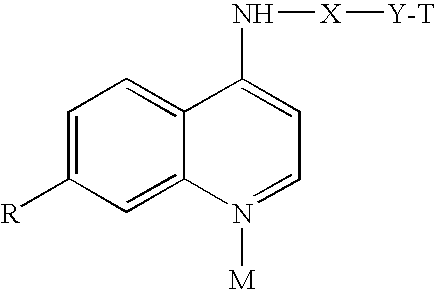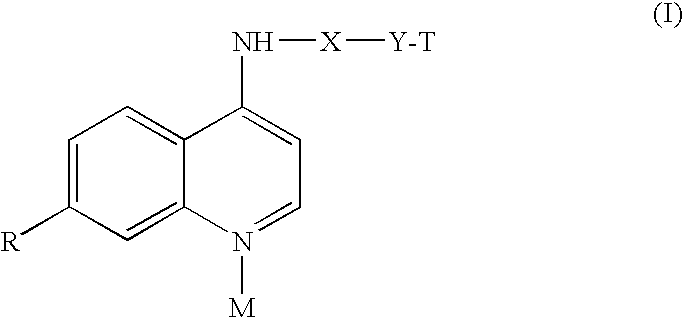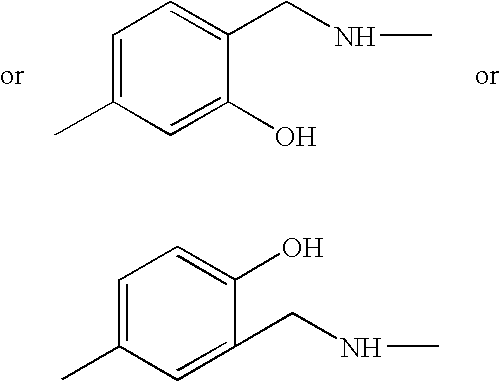4-Aminoquinoline Derivatives as Antimalarials
a technology of aminoquinoline and derivatives, applied in the field of new antimalarial compounds, can solve the problems of increasing malaria-related morbidity and mortality, accelerating the rate,
- Summary
- Abstract
- Description
- Claims
- Application Information
AI Technical Summary
Problems solved by technology
Method used
Image
Examples
example 1
Synthesis of N-(7-chloro-quinolin-4-yl)-2-(tetrahydropyrrolizin-7a-yl)-ethylamine
[0017]A mixture of 299 mg (1.94 mmol) of 5-(2-aminoethyl)-1-azabiciyclo[3.3.0]octane (prepared according to T. Suzuki et al., Chem. Pharm. Bull. 1997, 45, 1218), 384 mg (1.94 mmol) of 4,7-dichloroquinoline and 1.21 g (13.58 mmol) of phenol, was heated for 4 hrs at 180° C., stirring under nitrogen atmosphere. After cooling, 2N NaOH was added to the mixture until a basic pH was reached and the product was extracted with ether. After crystallization by ether, the product had a melting point of 123.6-125.3° C.
example 2
Synthesis of N-(7-chloro-quinolin-4-yl)-(tetrahydropyrrolizin-7a-yl)-methylamine
[0018]A mixture of 487 mg (3.46 mmol) of 5-aminomethyl-1-azabicyclo[3.3.0.]octane (prepared in according to T. Suzuki et al., Chem. Pharm. Bull. 1997, 45, 1218), 686 mg (3.46 mmol) of 4,7-dichloroquinoline and 2.28 g (24.26 mmol) of phenol, was heated for 4 hrs at 180° C., stirring under nitrogen atmosphere. After cooling, 2N NaOH was added to the mixture until a basic pH was reached and the product was extracted with ether. After crystallization by ethyl ether / petrol ether 7 / 3, the product had a melting point of 109.8-111.2° C.
example 3
Synthesis of 5-[(7-chloro-quinolin-4-yl)amino]-2-{[octahydroquinolizin-1-ylmethyl)-amino-]-methyl}-phenol
[0019]0.35 ml of aqueous formaldehyde were added to a solution of 780 mg (4.64 mmol) of aminolupinane (prepared from lupinine according to F. Sparatore et al. Farmaco, Ed. Sci. 1969, 24, 587) and 720 mg (4.64 mmol) of 3-acetamidophenol in 3.5 ml of ethanol. The mixture was heated under reflux for 24 hours, stirring under nitrogen. After cooling, the solvent was removed under reduced pressure and the crude material was purified by flash chromatography on silica gel column using dichloromethane / methanol 92 / 8 as eluent. The obtained product, N-(3-hydroxy-4-{[octahydroquinolizin-1-yl-methyl)-amino]-methyl}-phenyl)-acetamide, was washed with ethyl ether.
[0020]N-(3-hydroxy-4-{[octahydroquinolizin-1-yl-methyl)-amino]-methyl}-phenyl)-acetamide (380 mg, 0.93 mmol) was dissolved in 3 ml of 20% HCl and the solution was heated under reflux, under nitrogen for 8 hours. After evaporation under...
PUM
| Property | Measurement | Unit |
|---|---|---|
| Density | aaaaa | aaaaa |
| Density | aaaaa | aaaaa |
| Density | aaaaa | aaaaa |
Abstract
Description
Claims
Application Information
 Login to View More
Login to View More - R&D
- Intellectual Property
- Life Sciences
- Materials
- Tech Scout
- Unparalleled Data Quality
- Higher Quality Content
- 60% Fewer Hallucinations
Browse by: Latest US Patents, China's latest patents, Technical Efficacy Thesaurus, Application Domain, Technology Topic, Popular Technical Reports.
© 2025 PatSnap. All rights reserved.Legal|Privacy policy|Modern Slavery Act Transparency Statement|Sitemap|About US| Contact US: help@patsnap.com



